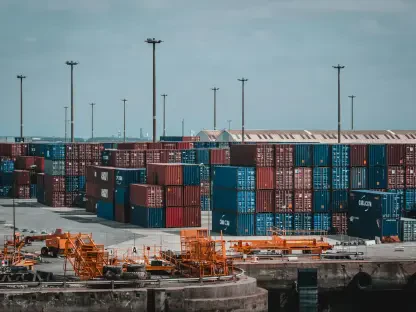The growing crisis in the U.S. homeowners insurance market is becoming increasingly difficult to ignore. As climate change leads to more frequent and severe natural disasters, insurance costs are skyrocketing, and coverage is dwindling. This article delves into the intricate dynamics behind these rising costs and the broader economic implications tied to climate change denialism.
Rising Insurance Costs and Coverage Penalties
Escalating Premiums and Reduced Coverage
Homeowners across the United States are facing a double-edged sword: soaring insurance premiums and diminishing coverage. This trend is particularly pronounced in high-risk areas prone to natural disasters such as hurricanes, wildfires, and floods. With the frequency and severity of these events increasing, private insurers are pulling out of these markets, leaving homeowners with few, if any, options. These circumstances are dire for homeowners who need protection but find themselves confronted with inflated costs for inadequate coverage. The rising premiums have made it almost impossible for many to afford insurance, causing a systemic problem within the industry and provoking broader economic implications.
The withdrawal of private insurers from high-risk markets has left a vacuum that is proving difficult to fill. Homeowners in these areas are forced to seek alternative forms of insurance, usually from state-backed programs that are meant to serve as a last resort. Unfortunately, these programs are typically underfunded and unable to provide comprehensive coverage. The insufficiency is stark, leaving a significant portion of homeowners underinsured. This situation places them at tremendous financial risk in the event of a natural disaster, further compounding the challenges faced by individuals and the housing market. The growing strain on these state programs highlights the need for more sustainable solutions.
State-Backed Programs Under Strain
In response to the exodus of private insurers, many states have established state-backed insurance programs as a safety net for homeowners. However, these programs are often insufficiently funded and ill-prepared to handle large-scale losses. These state-run entities, meant to bridge the gap left by the private sector, are finding themselves overwhelmed by the sheer volume of claims and the magnitude of potential payouts in the wake of natural disasters. The underfunded nature of these programs limits their effectiveness and puts them at risk of insolvency, leaving homeowners with inadequate safeguards and exposing the state to significant financial liability.
The dynamic between these state-backed programs and private insurers further exacerbates the overall instability in the homeowners insurance market. As more homeowners are forced to turn to state programs, the financial burden on these entities grows, stretching their already limited resources even thinner. This dependency on state-backed programs to absorb risk not only highlights the inadequacy of the current insurance model but also points to the long-term unsustainability of relying solely on underfunded state assistance. To address this growing crisis, there is a pressing need for a comprehensive overhaul that includes increased funding for these programs and enhanced collaboration with private insurers.
The Role of Climate Change Denial
Political and Economic Influences
A significant factor exacerbating the insurance crisis is the denial of climate change by powerful political entities and fossil fuel interests. This denialism creates a substantial barrier to implementing necessary regulatory measures that could mitigate the impact of climate-related risks. The influence of fossil fuel industries in shaping public policy and political discourse cannot be overstated. By funding campaigns and lobbying efforts that downplay or outright deny the reality of climate change, these interests ensure that meaningful action is stalled. This deliberate obfuscation has left both regulators and the insurance industry operating under outdated assumptions and inadequate regulatory frameworks.
The parallels between climate change denialism and historical revisionism in autocratic regimes are troubling. Much like regimes that rewrite history to suit their agenda, climate change denialists actively work to distort scientific evidence and suppress information that contradicts their narrative. This calculated disinformation campaign erodes public trust in scientific consensus on climate change and delays critical action. The political and economic landscape, such as brimming with fossil fuel interests, makes it incredibly challenging to enact the necessary reforms. The impact of this denialism is far-reaching, perpetuating a cycle of inaction and vulnerability that leaves the insurance market—and broader society—ill-prepared to face escalating climate risks.
Media Coverage vs. Political Inaction
While studies and reports highlighting the link between rising insurance costs and climate change are gaining media traction, political and economic forces continue to downplay these warnings. This disconnect between public awareness and political action is contributing to the growing instability in the insurance market. Media outlets have increasingly focused on the tangible impacts of climate change, from devastating wildfires to unprecedented flooding, thereby raising public awareness about the urgent need for action. However, despite the growing body of evidence and heightened media attention, meaningful legislative and regulatory responses have been slow to materialize.
The persistence of political inaction in the face of mounting evidence underscores a troubling trend. Powerful stakeholders, including fossil fuel companies and their political allies, continue to wield significant influence over policymaking. This influence often translates into a lack of urgency or outright resistance to regulatory changes that would address climate risks head-on. As a result, the insurance industry remains caught in a precarious position, with rising costs and coverage limitations straining both insurers and policyholders. The gap between the escalating urgency communicated by the media and the tepid response from political leaders highlights a critical failure in governance that exacerbates the broader crisis.
Broader Economic Implications
Impact on Homeowners and the Housing Market
The inability to secure affordable and comprehensive insurance has far-reaching consequences for homeowners. Without insurance, homeowners cannot obtain loans or mortgages, leading to broader economic instability and a potential downturn in the housing market. Insurance functions as a key prerequisite for securing financing for property purchases, and its unavailability creates a significant barrier to homeownership. This situation stifles market activity and restricts access to credit, thereby limiting economic mobility and exacerbating inequalities. The broader implications extend beyond individual homeowners, affecting communities and local economies reliant on a stable housing market.
The ripple effects of this insurance crisis are vast, impacting everything from property values to community resilience in the face of natural disasters. The shortage of affordable insurance coverage can lead to an increase in vacant and abandoned homes as property owners are unable to secure the necessary financial protections. This, in turn, could contribute to declining property values and tax revenues, further straining local governments already struggling with budget constraints. The housing market, a critical component of the broader economy, faces significant destabilization if the insurance crisis remains unaddressed. The potential economic fallout highlights the urgency of finding sustainable solutions to ensure that homeowners can access the insurance coverage they need.
Financial System Risks
The broader financial system is also at risk. Major banks continue to invest in fossil fuels, perpetuating the risk to financial stability. The lack of action by the Federal Reserve and other regulators is part of a vicious cycle that threatens the overall economic health of the country. Banks and financial institutions that remain heavily invested in fossil fuel projects are essentially underwriting the continued exacerbation of climate risks. This not only contributes to environmental degradation but also heightens the exposure of the financial sector to climate-related losses. The potential for economic destabilization is significant, with the insurance crisis serving as a bellwether for broader systemic vulnerabilities.
The interconnectedness of the financial system means that climate risks in the insurance sector can quickly spread to other parts of the economy. If insurers are unable to manage their exposure to climate-related risks, the resulting losses could trigger a domino effect, affecting lenders, investors, and ultimately, consumers. The 2008 financial crisis serves as a stark reminder of how interconnected systemic failures can lead to widespread economic turmoil. The reluctance of financial regulators to acknowledge and address these risks increases the likelihood of a similar crisis. A comprehensive response that includes stringent regulatory measures and a shift in investment priorities is essential to mitigate these vulnerabilities.
Market Responses and Mismanagement
Short-Term Strategies by Insurers
Major insurers, aware of the increasing risks, sometimes engage in short-term strategies such as underpricing insurance to gain market share. While this may provide temporary profits, it ultimately leads to insurers withdrawing from high-risk markets once the risks become unmanageable. This strategy, reminiscent of speculative bubbles in financial markets, creates an unsustainable boom-and-bust cycle within the insurance sector. By initially offering low premiums to attract customers, insurers expose themselves to higher-than-anticipated claims when natural disasters occur. When the financial strain becomes too great, these insurers exit the market, leaving policyholders in the lurch.
The short-term focus on market share at the expense of long-term sustainability is indicative of broader mismanagement within the insurance industry. The pressure to deliver short-term financial results often outweighs the necessary investment in risk management and climate adaptation strategies. This misalignment between short-term profit motives and long-term risk mitigation exacerbates the instability in the insurance market. As a result, homeowners are left without reliable coverage, and the financial burden is shifted to state-backed programs or the homeowners themselves. This cycle of entry and exit by insurers inherently undermines the stability and reliability of the insurance system, necessitating a reevaluation of industry practices.
Strain on the Reinsurance Market
The reinsurance market, which helps primary insurers manage risk, is also feeling the strain. European reinsurers are more openly recognizing the risks posed by global warming than their American counterparts, highlighting a significant divide in the industry’s response to climate change. Reinsurers play a critical role in distributing risk and providing financial backing to primary insurers, enabling them to cover larger and more catastrophic losses. However, the increasing frequency and severity of natural disasters are pushing the limits of what reinsurers can sustainably support. The acknowledgment of climate risks by European reinsurers and their proactive measures contrast sharply with the more cautious approach observed in the U.S. market.
The strain on the reinsurance market has significant implications for the broader insurance industry. If reinsurers become unable or unwilling to provide adequate support, primary insurers may face insurmountable financial challenges, further destabilizing the market. The divergent approaches between European and American reinsurers highlight the need for a more unified global response to climate risks. Collaboration and knowledge sharing across borders could lead to more resilient strategies and innovative solutions to manage climate-related risks. Addressing the strain on the reinsurance market is essential for ensuring the long-term sustainability of the insurance industry and its capacity to protect homeowners against escalating climate threats.
The Path Forward
Realistic Actuarial Standards
To address the growing crisis, there is a need for realistic actuarial standards that accurately reflect the increasing risks associated with climate change. This would involve a comprehensive reevaluation of how risks are assessed and managed in the insurance industry. Actuarial models must integrate the latest climate science and projections to provide a more accurate picture of future risks. By doing so, insurers can develop premiums that better reflect the true cost of coverage, ensuring financial stability while providing adequate protection for policyholders. The adoption of realistic actuarial standards is a crucial step toward making the insurance market more resilient and responsive to climate change.
Implementing these new standards will require collaboration between insurers, regulators, and climate scientists. The insurance industry must lead the way in revising its risk assessment methodologies to incorporate more dynamic and nuanced climate models. This change will enable insurers to price policies more accurately and to set aside appropriate reserves for potential claims. Regulatory bodies must also play a supportive role by endorsing these updated actuarial practices and ensuring compliance. The transition to realistic actuarial standards is an essential component of a broader strategy to stabilize the homeowners insurance market and mitigate the economic impacts of escalating climate risks.
Regulatory and Policy Changes
The growing crisis in the U.S. homeowners insurance market is becoming increasingly tough to ignore. As climate change brings about more frequent and severe natural disasters, insurance premiums are surging, and coverage options are shrinking. These escalating costs and declining coverage form a complex issue with significant economic impacts, especially when tied to the persistence of climate change denialism.
With hurricanes, wildfires, and floods occurring more regularly and with greater intensity due to a changing climate, insurers are finding themselves paying out more in claims. This leads to higher premiums as companies try to balance the risks and costs associated with covering properties in disaster-prone areas. In some cases, insurers are even withdrawing from high-risk regions altogether, leaving homeowners struggling to find adequate coverage.
The broader economic implications are troubling. Higher insurance costs can affect home values and the overall real estate market, as prospective buyers are deterred by the added expense. Local economies also suffer when natural disasters strike, leading to business closures, job losses, and costly recovery efforts. For many, the denial of climate change exacerbates these problems, delaying meaningful action and policy changes aimed at mitigating these risks. This article explores the complexities of this crisis and underscores the urgent need for addressing the root causes of rising insurance costs: the unchecked progression of climate change.









